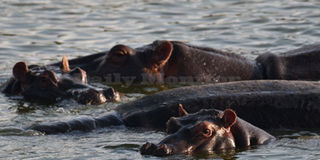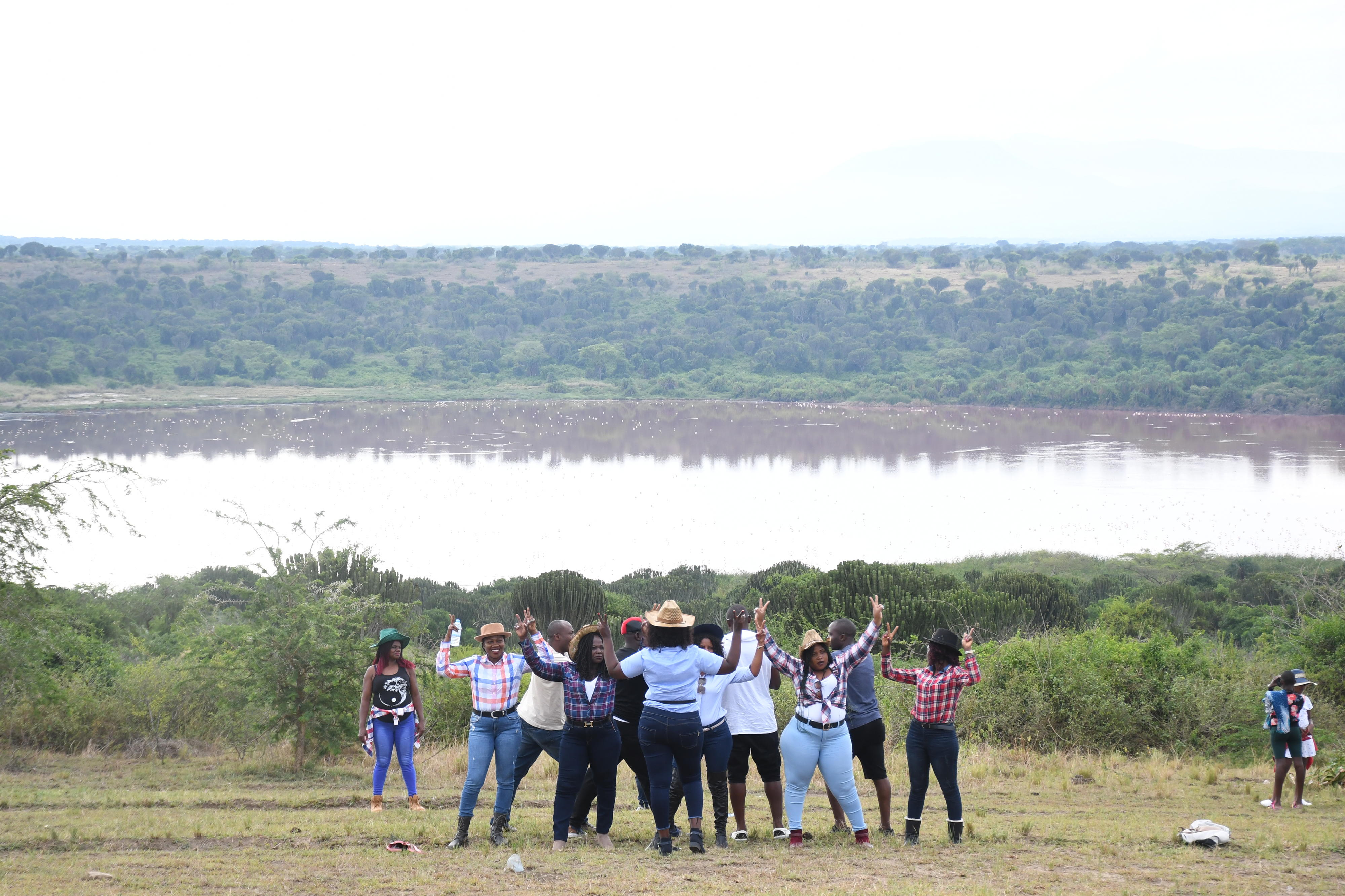Prime
Tourism actors reject bid for dam in Queen Elizabeth Park

Hippos are an imposing and attractive sight during a cruise along the Kazinga Channel that connects lakes, George and Edward, in Queen Elizabeth National Park. PHOTO/EDGAR R. BATTE
What you need to know:
- Currently, tourism ranks as the highest foreign exchanger earner. It also provides considerable employment, investment for the country.
Hotel and tour operators have asked the government to reject a proposal to build a hydro-electric power dam on River Kyambura in the Queen Elizabeth National Park.
The tourism sector players say the project will destroy one of the country’s most beautiful ecosystems.
They also say the project will undercut tourism, the biggest source of foreign exchange earner for the country.
Currently, tourism ranks as the highest foreign exchanger earner. It also provides considerable employment, investment, for the country and projects great promise for the future. World Bank data for 2019 indicates that in the financial year 2018/2019, tourism earned Uganda $1.6 billion (about Shs5.6 trillion) as of December 2019 from 1.6 million tourists.
Uganda’s tourism industry also created 536,600 jobs in 2019 and 321,960 jobs in 2020, sadly dropping 4 in 10 jobs in the wake of the pandemic.
The tour operators, who convened a press conference at Kampala Serena Hotel last week, asked both Christians, Muslim, and cultural leaders to reject the plan to build an electric power dam on River Kyambura.
The press conference was sparked off by an advert placed in newspapers by the Electricity Regulatory Authority (ERA).
The September 15 advert read: “Notice of Intended Application for a Licence from Rubirizi Energy EP (U) Limited for the Generation and sale of electricity on River Kyambura”. The advert also invited directly-affected parties and authorities to lodge any objections to the project.
Mr Boniface Byabakama, the vice chairperson of Uganda Hotel Owners Association and veteran tour operator, who chaired the meeting, said: “We are asking government not to even consider doing an environmental impact assessment to undertake this project because of the delicate ecosystem in Kyambura gorge.”
“We urge the Ministry of Finance to cut the budget of ERA because they are hell-bent on breaking conservation laws and advertising sites that are already gazetted and protected by an Act of Parliament,” he added.
“We also call upon the IGG to investigate the top officials in ERA because they don’t seem to fit the weight of their offices,” Mr Byabakama said.
Mr Byabakama called on foreign missions in Kampala to deny the leadership of ERA and their families visas to their respective countries.
He accused ERA of repeatedly considering bad proposals of disrupting nature and wildlife conservation activities in Murchison Falls National Park, and now in the Queen Elizabeth National Park.
Uganda’s most visited safari destinations are Queen Elizabeth National Park (QENP) and Murchison Falls National Park (MFNP).
The industry players, who were visibly upset, urged ERA to publicly withdraw the proposal to destroy the beauty of Kyambura gorge, reasoning that the country is already generating more power than can be consumed.
They urged the government to focus more on power distribution and less on destroying the environment in the name of building more power dams.
“We are saddened to learn of the move by ERA to build a dam on Kyambura river. Any development on the Kyambura river, which forms part of the habitat for the chimpanzees in the Kyambura gorge is going to negatively impact not just the environment that we have been conserving, but also Ugandans running tourism-related activities and businesses in this area,” said Ms Specioza Kawarach, an administrator from Mweya Safari Lodge, who also attended the media briefing.
“The great apes package, that is the chimps of Queen Elizabeth National Park, and the gorillas of Bwindi Impenetrable Forest, are a very popular tourist package among the European market,” she added.
About Kyambura Gorge
Kyambura river, on which the proposed dam would be built passes through Kyambura gorge, arguably one of the most beautiful landforms in the country. It is a narrow valley that resembles a huge crack in the ground, 100 meters deep, at the bottom of which lies the Kyambura river.
The breathtaking escarpments of the gorge are thickly forested, giving the impression of an underground forest in the middle of a semi-arid savannah wilderness. The breathtaking tourist destination is situated in the north-eastern part of QENP and spans a distance of 11km.
The underground forest of Kyambura gorge is a captivating eco system that happens to be home to the only habituated chimpanzee population in Queen Elizabeth National Park, on top of other primates like the red-tailed monkey, the black-and-white colobus monkey, the vervet monkey and baboons. The gorge is also home to hippopotamus and elephants, on top of being a habitat for 332 species of birds, making it a haven for bird tourists.
“A dam on this river would push the chimpanzees and other animals away from the gorge because they tend to shy away from any developed areas. This would push them into the nearby communities, causing endless human-wildlife conflicts,” Byabakama said.
Legal route
In the event that ERA goes ahead to approve the construction of the dam, the only option would be the legal route, according to the association.
While it is early to tell how things will fan out, UTOA leadership says they will not hesitate to go to court as long as ERA approves the construction of the power dam project.
“As per Article 50 of the Constitution, citizens can take on government in the courts of law through public interest litigation and challenge some of these decisions made by government entities,” says John Robert Turyakira, deputy executive director at Environmental Shield, who attended the press briefing.
Environmental Sheild is an environmental rights protection organisation in Kampala that has taken Hoima Sugar Ltd to the East African Court of Justice over the degradation of Bugoma forest. It is also challenging the issuance of an environmental impact assessment certificate to Hoima Sugar Ltd by national environmental agency Nema. Mr Turyahika attended the press briefing on the invitation of UTOA. Efforts to talk to ERA officials via phone were futile by press time.
Bugoma Forest
Another issue that was discussed at the media briefing was the Bugoma, a central forest reserve gazetted under The National Forestry and Tree Planting Act, 2003, and covers 41,144 hectares.
The forest is one of the most important places for biodiversity in Uganda, being the third chimpanzee sanctuary in the country with an estimate of 500 chimpanzees and a host of other unique species of mammals, which include the Ugandan Mangabeys, a rare monkey species only found in Bugoma Forest. It also hosts endangered species like the African Bush elephants and is home to 221 bird species.
“Indeed, this reserve is very important for the development of tourism and top eco-tourism business and investments like primates’ activities, which constitute the comparative advantage for Ugandan tourism,” a document provided by UTOA reads.
The current status of conservation of the forest under the National Forestry Authority and Ministry of Water and Environment is seen as very weak, and UTOA urges the government to be vigilant.
Not only is there the sensitive issue where Hoima Sugar Ltd is accused of encroaching on the gazetted forest but there are ownership issues between Bunyoro Kingdom and National Forestry Authority. According reports by this newspaper, Bunyoro Kingdom, which leased the land to the company, testified in court in early 2019 that the land under contestation was not part of the gazetted forest. The NFA disputed the claim and made its counter-submissions to prove its case, but failed to satisfy court that the leased land was part of the government forest.
“In May 2019, NFA lost the case. Court ruled that Hoima Sugar’s lease was valid and that NFA had failed to prove the alleged encroachment. National Environment Management Authority (Nema) also issued an impact assessment report in favour of Hoima Sugar, thus undermining the credibility of the claim that the company was degrading the forest,” the newspaper report stated.
“We have taken Hoima Sugar Limited to the East African Court of Justice. As we speak now the Attorney General has just given us a positive response on the matter. The reason we went to the East African Court of Justice is because environmental and climate change issues are regional and global issues. What happens in Bugoma Forest has a big impact on the whole region. So we feel that the regional court needs to hear this case,” Turyakira said.
He added, “The environment act provides that the company must carry out an environmental impact assessment study. Someone here said that the company has a problem with environmentalists. We believe that the company has a problem with Ugandans.”
Issue...Funding
“We urge the Ministry of Finance to cut the budget of ERA because they are hell-bent on breaking conservation laws and advertising sites that are already gazetted and protected by an Act of Parliament,” Mr Boniface Byabakama, the vice chairperson of Uganda Hotel Owners Association.




